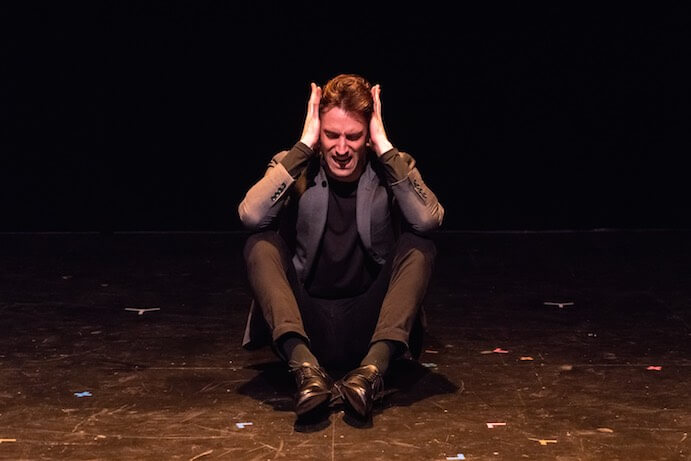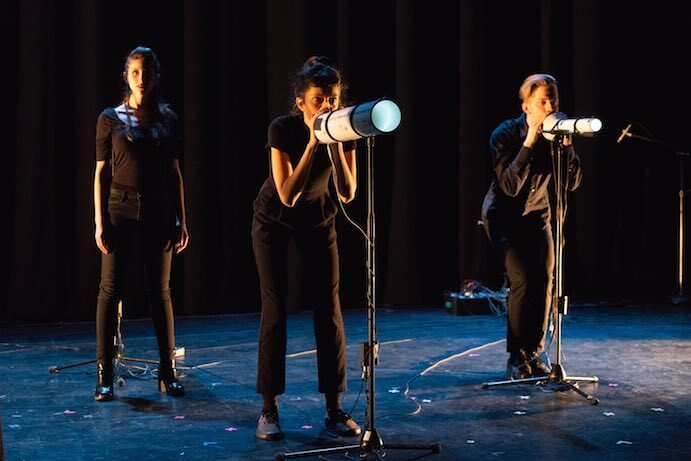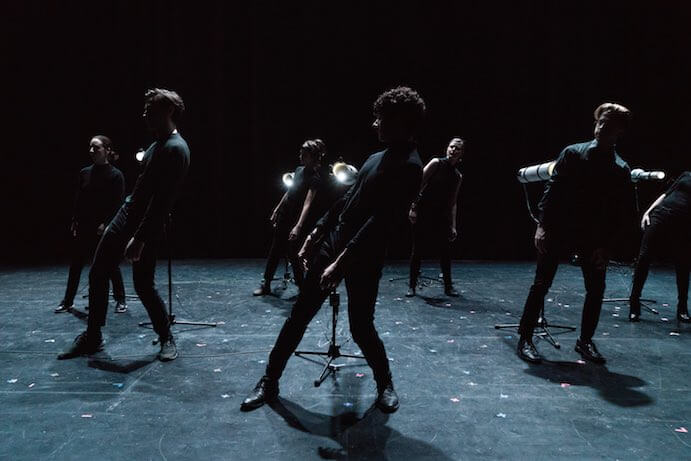“What was once a failure or challenge is now commonplace…over the past twenty years, we have embraced all manners of new music,” reflected MATA Festival Executive Director Todd Tarantino. With MATA’s final main stage concert “Contemporaneous: Stop Motion” on April 14, 2018, the festival stuck to its commitments with an eclectic and theatrical concert experience performed by the ensemble Contemporaneous.
Oftentimes, contemporary music series and ensembles specialize in certain school or style–but “Stop Motion” as a whole stood out in its embrace of challenge and variety, featuring works that spanned continents and styles. Contemporaneous performed with captivating and whole-hearted commitment in the face of six pieces by six very different composers. Over the course of the evening, this group young musicians (and one actor) played, danced, yelled, stomped, and swayed as they moved from one unusual formation to the next.
One of the most unexpected works on the program was Lasse D. Hansen’s Face the Music (2016), an experimental theater piece that journeys through the psyche of a composer (wonderfully played by actor Matthew Lieff Christian) lecturing on the topic of how people perceive music. Over the course of the piece, Christian’s character journeys from the lecture hall through chaotic realms of the conscious and sub-conscious, the formal facade of the professor-expert rapidly dissolving into a mess of inner turmoil. While the self-abasing inner-dialogue of the neurotic male artist/academic is as well-used as the expression “face the music” itself, Hansen embraces kitsch and cliché with a sense of humor. There were many enjoyable moments that highlighted absurdity of academia—“Music can keep you in the same place or take you to a different place”—or the humor of the inner psyche—at one point the main character is hypnotized by a disembodied female voice he calls “mother.”

Matthew Lieff Christian performs Lasse D. Hansen’s Face the Music–Photo by Steve Pisano
While Face the Music played with traditional ideas of a musical performance by bringing academia and theater in the concert hall, Jenna Lyle’s Let them stop swaying then there won’t be wind threw them out altogether. The sound-world of Lyle’s piece is built around static-sounding electronics and featured rows of various heavily-amplified PVC pipes, each serving as instruments for the musicians. Most interestingly, the piece utilized each player’s body to create various low, percussive sounds by rapidly moving the air next to each amplified pipe. The combined result was incredibly visceral and, for a period of time, effective, yet the stagnant development over this rather lengthy work detracted from the power of the percussive sounds.
The rest of the program featured comparatively traditional works. David Kirkland Garner uses the multi-layered possibilities of mixing electronics and instrumentalists in his piece DwnByThRckyMtns. Based on the spiritual “Down by the Rocky Mountains,” the piece is built around an old 1939 recording of songs sung by prisoners awaiting execution at the Florida State Prison in Railford, Florida. The sweet crooning of the old record in the electronics form a duet with muted trombone, evoking a uniquely American pastime–simultaneously disturbing and nostalgic.
There was also a arrangement of Jennifer Higdon’s DASH (2001/2018), a whimsical short trio arranged for flute, violin and piano. The players “dash” via rapidly passing scalar passages, but the performance had small discrepancies between players’ timing and articulation that detracted from the piece’s momentum. Perhaps DASH would be a nice addition on a concert of similar style chamber repertoire; within the scheme of “Stop Motion,” it came across as more of a virtuoso ditty than a meaningful commentary on the fast-paced nature of twenty-first century life where, as the program noted, “speed seems to be our goal.”

Contemporaneous at MATA 2018–Photo by Steve Pisano
The final two works of the program, William Dougherty’s a stillness of zero sensation and Andreas Eduardo Frank’s Samourï Progressive, were starkly different worlds of sound and gave Contemporaneous a chance to show the breadth of their their collective range as an ensemble. In a stillness of zero sensation, the players were seated in an open circle, seamlessly blending their sounds in a spectral cloud of microtones and harmonics that put the audience into a meditative and trance-like state. Samourï Progressive, by contrast, was a series of rhythmic grunts, stomps and percussive instrumental hits. Players were seated in rows with conductor David Bloom at the helm, like a leader commanding a military band. The intensity of the piece’s rhythmic punches is amplified by the frequent use of silence, occasionally disturbed in Contemporaneous’ performance by a tentative or rogue entrance, but all in all, it was an emphatic conclusion to the night.
In this kind of adventurous programming, the larger connections from one piece to another often stand out as much as any individual work. In “Stop Motion,” textured sounds of Americana from DwnByThRckyMtns resonated in a stillness of zero sensation, and the militaristic Samourï Progressive highlighted the dueling nature of order and chaos from Let them stop swaying then there won’t be wind. Over the course of the evening, it was clear that with open-minded programming comes mind-opening listening. Let’s hope that MATA’s stylistically wide-ranging programming will continue to influence and thrive within the New York new music scene.























